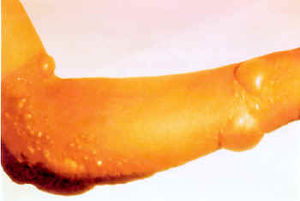We need you! Join our contributor community and become a WikEM editor through our open and transparent promotion process.
Blister chemical agents
From WikEM
Contents
Background
- Highly persistent
- Skin primary route of exposure when in liquid form; pulmonary and GI tracts as routes in vapor form
Types
- Lewisite (L)
- Sulfur mustard (H)
- Phosgene oxime (CX)
Pathophysiology
- Alkylation of DNA, RNA, and protein causing cell death
- Depletes glutathione causing cellular membrane breakdown
Clinical Features
- Skin – Initially pruritus and stinging pain, superficial bullae appear over 24 hours. Blisters do not contain toxin
- GI – abdominal pain, nausea, vomiting, diarrhea, and weight loss
- Respiratory –
- Usually only upper respiratory tract affected
- Sinus congestion, sore throat, hoarseness. Rarely pulmonary edema
- Epithelial sloughing and pseudomembranes causing inability to clear pathogens and dead tissue.
- Mucous membranes and actively reproducing cells most vulnerable to severe damage
- Ocular damage – occurs within 4-8 hours
- conjunctivitis, chemosis, blepharospasm, and corneal perforation at even low level exposures
- Bone Marrow – Leukopenia first (3-5 days), followed by anemia and thrombocytopenia
Differential Diagnosis
Chemical weapons
- Blister chemical agents (Vesicants)
- Lewisite (L)
- Sulfur mustard (H)
- Phosgene oxime (CX)
- Pulmonary chemical agents
- Incendiary agents
- Cyanide chemical weapon agents
- Nerve Agents
- Acetylcholinesterase inhibitors
- Includes household and commercial pesticides (diazinon and parathion)
- G-series (sarin, tabun, soman) and V-series (VX)
- V-series high viscosity with oily consistency
Evaluation
Management
- Immediate decontamination, 0.5% hypochlorite solution will inactivate sulfur mustard but not appropriate for pediatric patients
- Supportive care, ABCs
- Thermal burn-type care
- Fluid losses less than with thermal burns
- No antidotes for mustard agents
- N-acetylcysteine, glutathione
- G-CSF for patients with bone marrow suppression
- British antilewisite (BAL) – chelating agent to reduce systemic effects from lewisite exposure.
- Won’t alter the blistering effects on skin or airway.
- Only used for patients with shock or severe pulmonary injury given BAL side effect
- Relative contraindications to BAL: Renal disease, pregnancy
Disposition
See Also
Authors
Ross Donaldson, Rafael Caban, Kevin Lu, Claire, Daniel Ostermayer, Neil Young

